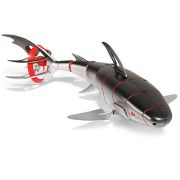 Methinks I could have lots of fun at the beach this summer with this remote control robotic shark.
Methinks I could have lots of fun at the beach this summer with this remote control robotic shark.What would you do if you saw the fin approaching you while swimming?
 Methinks I could have lots of fun at the beach this summer with this remote control robotic shark.
Methinks I could have lots of fun at the beach this summer with this remote control robotic shark.Oh, a very timely question. I'm not sure how we ended up talking so quickly about sailing boats on a reach when trying to answer such a fundamental question. Although the bloggers do mention other very increasing factoids, they play a role much later in understanding the concept. There are two camps these days. In my opinion both camps play a role in helping us to understand the ways of wings and/or sails. Why should we keep two theories around? Maybe an analogy is handy. Einstein proposed that light acted both as a particle and as a wave. So far, no one has proved him wrong and both are used.I especially like his or her explanation of why having two opposing theories may have practical value (even when one of them actually fits much better with the experimental data.)
The first aerodynamic explanation is the good 'ole Bernoulli concept. You nailed the description. Lift is generated by the change in the speed of air as it moves across the two sides of the sail or wing. On one side, the pressure lowers and the other side sees ambient pressure, or slightly higher. Differentially, a force is created in the direction of the low pressure on the leeward side.
The second theory is the Circulation Theory. In this theory the apparent wind approaching the lifting body (sail or wing) sees a low pressure area and bends dramatically to get to that low pressure. It is this bending motion that transfers energy to the sail -- conservation of energy. Circulation theory seems to have it biggest value in explaining slot effect. Slot effect? On a wing, slots are found as either leading or trailing surfaces. On sails, the jib forms a slot with the main sail. Forming a good, efficient slot is apparently a black art. However, the circulation theorist will show you wind tunnel results to prove that the Bernoulli (Bernie) Law falls apart when used to describe a slot. Typically Bernie says the air speeds up even more in the slot, producing more lift. Circulation theory predicts, "Nope, it slows down." Wind tunnel results say, "It slows down."
 I know you all thought I was crazy for raising the question of helmets for sailors in my post Blood on the Decks.
I know you all thought I was crazy for raising the question of helmets for sailors in my post Blood on the Decks.But here's a pic of some dude wearing one in the Volvo Ocean Race.
 Check out the M4 - a new hydrofoiling sailing dinghy. According to the designer the main brief was that "the design could be given to a good club sailor for an afternoons foiling so more people can enjoy the thrills and spills of this new form of dinghy sailing’."
Check out the M4 - a new hydrofoiling sailing dinghy. According to the designer the main brief was that "the design could be given to a good club sailor for an afternoons foiling so more people can enjoy the thrills and spills of this new form of dinghy sailing’."
I go for another quick roast in the sun until it's time for my sailing lesson with Jerry, as laid-back as his magnificent dreadlocks suggest. He laughs when I tell him I hate boats. You'll be fine, he says. And actually it's not bad. He drags it into the water and does most of the driving. Then he shows me how to get the sail going with the rope and we are soon whizzing along, turning the corner (as, perhaps, they don't say in the Round the World Yacht Race), and whizzing back again. Yes, there's some technical detail about prevailing winds, which blows in one ear and out of the other, and confusing moments with the tiller, an apparatus that defies all human intuition unless you happen to drive a car with the steering wheel at the back. But I must admit it is quite exhilarating, even with my hamstrings.
 What are these guys doing?
What are these guys doing? There's a small, narrow lake across the road from my house with a boat launching ramp about 100 yards from the house. It's not a great lake for sailing as it's surrounded by houses and trees and a large hill to the west. When the wind's from the northwest it's unstable and gusty. When the wind's from the west it swirls around each side of the hill in turn and comes in from alternate ends of the lake at random intervals. When the wind's from the east it's weak and damp. On the rare occasions when the wind blows from the south it's sorta kinda OK for sailing.
There's a small, narrow lake across the road from my house with a boat launching ramp about 100 yards from the house. It's not a great lake for sailing as it's surrounded by houses and trees and a large hill to the west. When the wind's from the northwest it's unstable and gusty. When the wind's from the west it swirls around each side of the hill in turn and comes in from alternate ends of the lake at random intervals. When the wind's from the east it's weak and damp. On the rare occasions when the wind blows from the south it's sorta kinda OK for sailing. Back in the summer, when I told the commodore of my sailing club that I was expecting to become a grandfather in November, he told me that it would be a "life changing event".
Back in the summer, when I told the commodore of my sailing club that I was expecting to become a grandfather in November, he told me that it would be a "life changing event".

Sure, it's been fun joking about the fact that Dick Cheney obtained five -- count them, five -- deferments to avoid serving in the military during the Vietnam War. Sure, its been amusing to recount his limp claim that the man who served as George Bush I's Secretary of Defense had "other priorities" than taking up arms in defense of his country. Sure, it was a laugh when the chief cheerleader for the war in Iraq mocked John Kerry for having actually carried a weapon in a time of war.
But it is time to stop laughing at Dick Cheney's expense.
Now that the vice president has accidentally shot and wounded a companion on a quail hunt at the elite Texas ranch where rich men play with guns -- spraying his 78-year-old victim, er, friend, in the face and chest with shotgun pellets and sending the man to intensive care unit of a Corpus Christi hospital -- it has become clear that Cheney was doing the country a service when he avoided service.The man Cheney misstook for a quail, millionaire attorney Harry Whittington, was in plain sight, wearing a bright orange vest at the time the vice president blasted him.
U.S. troops had enough problems in Vietnam without letting a trigger-happy incompetent like Dick Cheney start shooting things up from behind the lines.
Those deferments were well and wisely issued.
 Every sailing club has one. An old curmudgeon who complains about the way the club is being run now, how it's not the same as when he was commodore back in the 30s, writing obnoxious notes to the committee, how dare they charge such exorbitant fees for regattas, blah blah blah ...
Every sailing club has one. An old curmudgeon who complains about the way the club is being run now, how it's not the same as when he was commodore back in the 30s, writing obnoxious notes to the committee, how dare they charge such exorbitant fees for regattas, blah blah blah ... Did you catch the Rolling Stones concert in Detroit on Sunday night? Great that ABC showed it on prime-time TV. (Shame that it was preceded and followed by several hours of coverage of overweight, overpaid, overexcited, overdressed men in tight pants running into each other and falling over.)
Did you catch the Rolling Stones concert in Detroit on Sunday night? Great that ABC showed it on prime-time TV. (Shame that it was preceded and followed by several hours of coverage of overweight, overpaid, overexcited, overdressed men in tight pants running into each other and falling over.)succulento a directory of blog that they deal of sail!OK. I'm off to "ravanare goodness knows where" for a spot of "agonistica".
it is clear: They do not only deal of sail, best ONLY SOME ONLY deal of sail, but ce they are also various that face the argument with a cut say. more heuristic?
In any case the sail guesses there always, a lot that are agonistica sail, cruise, bricolage, photography, etc, but other guesses also a lot there, therefore the heterogenous offer e quantomai, without to count that with all the connected ones link, can be gone to ravanare goodness knows where.
Those under are already active here, how much before will be available also in bottom to the right column, therefore good travel, to how many will attempt!






But whatever the quarrel, whoever her foes,
Let them come! Let them come when they will!
Though the struggle be grim, 'tis Australia that knows,
That her children shall fight while the Waratah grows,
And the Wattle blooms out on the hill.
And we must sing a rebel song
And join in rebel chorus.
We'll make the tyrants feel the sting
O' those that they would throttle;
They needn't say the fault is ours
If blood should stain the wattle!
 Damn it.
Damn it. When I wrote a post some months ago mentioning a certain body part it generated way too many google hits from weirdos who were almost certainly not looking for my personal accounts of running and sailing. So I will simply say that this product BODYGLIDE has provided the necessary lubrication to enable me to complete two marathons in comfort.
When I wrote a post some months ago mentioning a certain body part it generated way too many google hits from weirdos who were almost certainly not looking for my personal accounts of running and sailing. So I will simply say that this product BODYGLIDE has provided the necessary lubrication to enable me to complete two marathons in comfort.
Imbrication? Sociality? Geeze this is getting heavy.
Slow living involves the conscious negotiation of the different temporalities which make up our everyday lives, deriving from a commitment to occupy time more attentively. This article considers the significance of time in practices of slow living and the imbrication of time and speed in notions of 'slowness' where slowness is constructed as a deliberate subversion of the dominance of speed. By purposely adopting slowness, subjects seek to generate alternative practices of work and leisure, family and sociality.